|
● Football
● How
the Game Is Played
● Baseball
● How
the Game Is Played
● Basketball
● How
the Game Is Played
● Other
Sports Activities
Text
 Watching
or attending sports events is an important part of the lives of
many Americans. What are some of these sports, and how do they affect
the lives of the people? Watching
or attending sports events is an important part of the lives of
many Americans. What are some of these sports, and how do they affect
the lives of the people?
Football
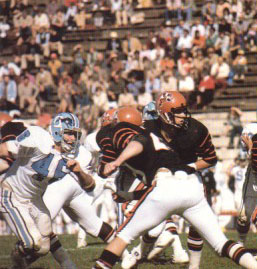 |
|
American Football
|
 Sunday
morning in thousands of American homes adults are hurrying to pack
frankfurters, hamburgers, and sausages, with rolls
and buns, mustard and ketchup, and various relishes:
onions, pickles and the like. Bags of potato chips,
pretzels, and peanuts are also gathered up. There is also
the portable grill to get ready as well as a cooler filled with
ice, beer and soda water. All of this food is for the "tailgate"
party at the football game. Sunday
morning in thousands of American homes adults are hurrying to pack
frankfurters, hamburgers, and sausages, with rolls
and buns, mustard and ketchup, and various relishes:
onions, pickles and the like. Bags of potato chips,
pretzels, and peanuts are also gathered up. There is also
the portable grill to get ready as well as a cooler filled with
ice, beer and soda water. All of this food is for the "tailgate"
party at the football game.
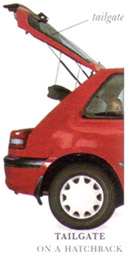 |
|
The Tailgate
|
(Station wagon automobiles, popular
a few years ago, had a rear door that opened horizontally.
It was called, after the rear gate of horse drawn wagons, the tailgate.
When the car was parked in a lot, the tailgate was lowered and food
and drinks were placed on it. Thus, a tailgate party.)
 For
those many other thousands not actually attending the game, a party
nonetheless is held in front of a TV set, where one can watch three
different games on a single Sunday afternoon and evening. American
professional football is played during the late summer (preseason),
the fall (regular season), and the winter until late in January
(post-season, or play off time ). All this culminates
in the Super Bowl to decide the
champion team for the year. There are now twenty four teams divided
into two conferences, the American Football Conference (AFC) and
the National Football Conference (NFC). These teams are located
throughout the country from Seattle to Miami, from San Diego to
New England. For
those many other thousands not actually attending the game, a party
nonetheless is held in front of a TV set, where one can watch three
different games on a single Sunday afternoon and evening. American
professional football is played during the late summer (preseason),
the fall (regular season), and the winter until late in January
(post-season, or play off time ). All this culminates
in the Super Bowl to decide the
champion team for the year. There are now twenty four teams divided
into two conferences, the American Football Conference (AFC) and
the National Football Conference (NFC). These teams are located
throughout the country from Seattle to Miami, from San Diego to
New England.
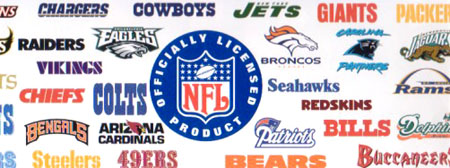 |
|
NFL Members
|
 Professional
sports in America is entertainment, especially football. Spectators
are as much interested in eating and drinking as they are in the
game itself. It is a time to party. And a time to advertise products
for consumption. It was not always so. Professional football used
to be a minor activity on the American scene. Because games were
played only once a week, a football stadium had to accommodate
many paying customers, so they were quite large. The largest stadium
today is the Pontiac Silverdome in Michigan with a capacity of a
little over 80000 seats, and the smallest is the Oakland Coliseum
in California seating just 50000 people. A large area of Professional
sports in America is entertainment, especially football. Spectators
are as much interested in eating and drinking as they are in the
game itself. It is a time to party. And a time to advertise products
for consumption. It was not always so. Professional football used
to be a minor activity on the American scene. Because games were
played only once a week, a football stadium had to accommodate
many paying customers, so they were quite large. The largest stadium
today is the Pontiac Silverdome in Michigan with a capacity of a
little over 80000 seats, and the smallest is the Oakland Coliseum
in California seating just 50000 people. A large area of
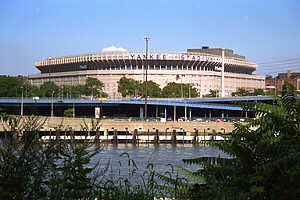 |
|
The Yankee Stadium
|
land in the middle of a city is very
expensive, and it would be essentially idle for days at a time.
Thus stadiums were located on the fringes of cities or a
waterfront land if that was available. But this made it difficult
for spectators to attend.
 Interest
in professional football suddenly increased with the advent
of color television. It had to be color television and not the simple
black-and-white sort, because without viewing colors, the players
on opposing teams cannot easily be distinguished, making it quite
difficult to follow the game. With color, the teams are easily distinguished,
and the pageantry, the colored banners and flags, heighten
the visual interest. Technically advanced equipment permitted home
viewers to see a replay, sometimes in slow motion.
More experienced cameramen, with more cameras available, were able
to anticipate unusual plays and follow the movement of the ball
more closely. And announcers were able to describe the game and
explain it to home viewers, and even provide background information
about the players and owners. Television producers made arrangements
with the officials to take intermissions from play so that
corporate sponsors could broadcast commercials during the
course of the game, rather than waiting until the end of a set period.
Furthermore, games could be broadcast every week, with different
games played at different times. All of this led to increased interest
on the part of spectators, who now were more willing to leave their
comfortable homes where they could watch on television, and travel
to a far away stadium to join with other fans in attendance. Notice
that one can view the game more clearly at home than one can see
it from most seats in an enormous stadium, so the social aspects
of being there with others is an important motivation for attending
the game in person. Many stadiums today have a large screen visible
from the seating area and capable of displaying a television picture.
So even those spectators at the stadium itself can see "instant
replays" of events on the field that they were unable to
see from their seats. Interest
in professional football suddenly increased with the advent
of color television. It had to be color television and not the simple
black-and-white sort, because without viewing colors, the players
on opposing teams cannot easily be distinguished, making it quite
difficult to follow the game. With color, the teams are easily distinguished,
and the pageantry, the colored banners and flags, heighten
the visual interest. Technically advanced equipment permitted home
viewers to see a replay, sometimes in slow motion.
More experienced cameramen, with more cameras available, were able
to anticipate unusual plays and follow the movement of the ball
more closely. And announcers were able to describe the game and
explain it to home viewers, and even provide background information
about the players and owners. Television producers made arrangements
with the officials to take intermissions from play so that
corporate sponsors could broadcast commercials during the
course of the game, rather than waiting until the end of a set period.
Furthermore, games could be broadcast every week, with different
games played at different times. All of this led to increased interest
on the part of spectators, who now were more willing to leave their
comfortable homes where they could watch on television, and travel
to a far away stadium to join with other fans in attendance. Notice
that one can view the game more clearly at home than one can see
it from most seats in an enormous stadium, so the social aspects
of being there with others is an important motivation for attending
the game in person. Many stadiums today have a large screen visible
from the seating area and capable of displaying a television picture.
So even those spectators at the stadium itself can see "instant
replays" of events on the field that they were unable to
see from their seats.
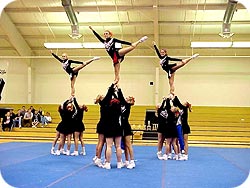 |
|
Cheerleaders
|
 In
addition to professional football, most colleges and universities
have a varsity football team, with additional personnel in
a marching band and a squad of cheerleaders,
whose task is to lead the spectators in cheering for their team.
The marching band and cheerleaders usually provide entertainment
during the major intermission halfway through the game. In
addition to professional football, most colleges and universities
have a varsity football team, with additional personnel in
a marching band and a squad of cheerleaders,
whose task is to lead the spectators in cheering for their team.
The marching band and cheerleaders usually provide entertainment
during the major intermission halfway through the game.
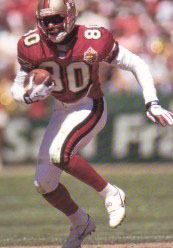 |
|
A Runner
|
 One
reason football is so popular in America may be that the game combines
teamwork with individual prowess in
a rough, contact competition. The football hero is a
ball carrier who can evade the defensive team, all of whom
are trying to stop him. This explains why runners like O.J.
Simpson became famous, while those teammates who protected
him from the rushing defensive players are unknown. Similarly, an
effective defensive player, who is able to move through the protection
and stop the ball carrier, will often become famous. One
reason football is so popular in America may be that the game combines
teamwork with individual prowess in
a rough, contact competition. The football hero is a
ball carrier who can evade the defensive team, all of whom
are trying to stop him. This explains why runners like O.J.
Simpson became famous, while those teammates who protected
him from the rushing defensive players are unknown. Similarly, an
effective defensive player, who is able to move through the protection
and stop the ball carrier, will often become famous.
 Americans
like to glorify individuals who succeed in overcoming obstacles,
natural ones as well as those presented by others. Perhaps
this inclination is not peculiar to Americans. Americans
like to glorify individuals who succeed in overcoming obstacles,
natural ones as well as those presented by others. Perhaps
this inclination is not peculiar to Americans.
Previous Page Next
Page
|

